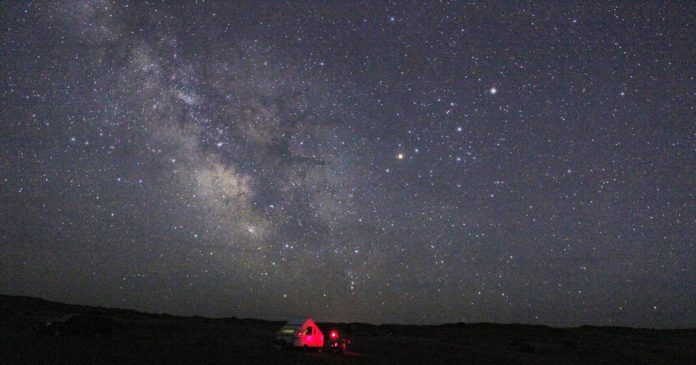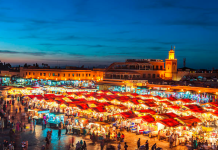VALENTINE – In September 2022, Merritt Reservoir State Recreation Area became the first International Dark Sky Park in Nebraska. This certification came from the International Dark-Sky Association, the world’s leading authority on light pollution and night sky preservation. It marked a huge milestone in elevating Nebraska as an astrotourism destination.
Astrotourists often travel miles from their hometown to experience a dark sky, typically in rural areas where there is little to no light pollution. Though the idea may seem unremarkable to some, 80% of North Americans can’t see the Milky Way at night, according to NPR.
International Dark Sky Parks are “publicly- or privately-owned spaces protected for natural conservation that implement good outdoor lighting and provide dark sky programs for visitors,” according to the association’s website. Parks are one of five types of designations offered by the International Dark Sky Places Program, which was founded in 2001.
People are also reading…
Other designations include International Dark Sky Communities, International Dark Sky Reserves, International Dark Sky Sanctuaries and Urban Night Sky Places. Each has its own set of guidelines depending on the land management, size and sky quality.
Jenna Bartja, adventure travel specialist at the Nebraska Tourism Commission, began the application for Merritt in the fall of 2018. She had just moved to Nebraska from Flagstaff, Arizona, the first Dark Sky City in the United States, which gave her the idea to look for dark skies in the state.
She has since been at the forefront of promoting Nebraska as an astrotourism destination.
“I became interested in astrotourism because it has been increasing in popularity in recent years,” she said. “I saw it as an opportunity to create positive perceptions about Nebraska and increase the scope of offerings tourism destinations here can advertise.”
Currently, there are several other locations in Nebraska that are considering pursuing an International Dark Sky Place designation including Niobrara National Scenic River in Valentine, Willa Cather Memorial Prairie in Red Cloud and either Scotts Bluff National Monument or Wildcat Hills State Recreation Area in Gering. Bartja estimated that Willa Cather Memorial Prairie will be certified by the end of the year.
“I don’t think there is an ideal number we should aim for, but designating as many as we can could go a long way in changing perceptions about our state,” she said. “Building a handful of designations peripherally will really help to show that we’re part of that elite network of dark sky destinations.”
A Dark Sky Place designation requires a rigorous application process. Bartja first had to conduct initial sky quality readings to confirm Merritt met the requirements for a designation and create a budget proposal to update Merritt’s outdoor lighting to be dark sky friendly (all bulbs had to be 3,000 Kelvin or less and fully shielded).
From there, she met with Nebraska Game and Parks Commission officials, who, as land managers, had to agree to the investment before she began the formalized process. That process included many rounds of intensive editing to the application, six more sky-quality surveys and developing dedicated educational programming, resulting in a 110-page application.
Merritt met the more intense sky quality requirements to become an International Dark Sky Sanctuary, of which there are only 15 in the world. However, the land managers were not interested in pursuing a designation because it would have to include the Wildlife Management Area, which they never intended to designate.
A starry night sky isn’t as tangible as a cool monument or waterpark and therefore is more difficult to market. However, something that has already drawn interest in the area and what made Merritt an ideal place to start is the annual Nebraska Star Party hosted at the campground.
“A lot of people that live in rural areas that live under really pristine, dark skies don’t necessarily see or value that as an actual asset,” Bartja said. “So having Merritt be the host site of Nebraska Star Party for so many years really built that awareness that ‘Hey, all these people keep coming to our community, and it’s just to look at the stars.’”
For 29 years, the event has drawn hundreds of travelers for a week of stargazing activities. The event is planned two to three years out for a week with a new moon between the end of July and early August. John Johnson, one of the event organizers, said about half of the people who attend are from out of state, and those visiting for the first time often become emotional after seeing the Milky Way.
“I’ve seen people once they get out there and their eyes get dark adapted, almost break down and cry because they’ve never seen anything like that,” he said. “It’s truly an awe-inspiring event to be out there under the dark skies like that.”
Something else that has brought more visitors to the area is camping. During the COVID-19 pandemic, Cherry County experienced an influx in tourism, despite the travel industry being one of the hardest hit industries globally. Regina Osburn, director of Cherry County tourism, said the dark skies are an inexpensive way for families to connect with nature that can’t be experienced everywhere.
“Our tagline has always been, ‘We’re halfway from anywhere, but we’re in the middle of nowhere. Perfect.’” she said. “It’s a perfect resting spot to just spend maybe a day or two within your vacation time and to have a whole other experience.”
Merritt Reservoir State Recreation Area, 26 miles southwest of Valentine, is open 24 hours a day. A park entry permit is required and may be purchased at the park or online in advance.
Be the first to know
Get local news delivered to your inbox!













